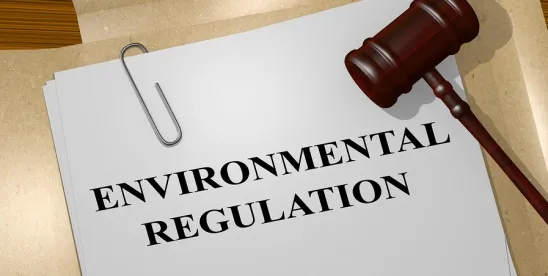On November 12, 2024, in Marin Audubon Society v. Federal Aviation Administration, the Court of Appeals for the District of Columbia ruled that the Council on Environmental Quality (“CEQ”) lacks authority to issue government-wide National Environmental Policy Act (“NEPA”) regulations. Although none of the parties raised the issue in their briefs, in an opinion issued by a split 2-1 panel, the court found CEQ’s regulations—which have been in force for over 40 years—to be invalid. The case is likely to have far-reaching implications.
Despite many uncertainties regarding the decision’s potential impacts, a few things are not in doubt:
- The NEPA statute remains in effect.
- CEQ NEPA guidance (as distinct from regulation) is unaffected.
- Confusion about the decision poses a risk of delays in ongoing and upcoming NEPA reviews until the dust settles, which could take several years.
The Court’s Opinion
Petitioners, including the Marin Audubon Society, challenged the Federal Aviation Administration’s (“FAA”) and the National Park Service’s (“NPS”) decision not to complete an environmental review under NEPA of an Air Tour Management Plan governing tourist flights over national parks near San Francisco, California.
The court noted that, although the parties’ arguments focused on whether the FAA and NPS complied with the CEQ NEPA regulations, the court would “not address these regulations.” Instead, and despite the fact no parties raised the issue, the court held on its own accord that CEQ’s NEPA regulations, “which purport to govern how all federal agencies must comply with [NEPA], are ultra vires,” or beyond CEQ’s legal authority. Tracing the origins of CEQ’s NEPA regulations, the court pointed out that CEQ’s claimed rulemaking authority was tied to a Presidential Executive Order that did not provide CEQ with “lawful authority to promulgate these regulations.”
The court acknowledged that NEPA provides other federal agencies authority to adopt their own NEPA implementing regulations. The court considered the question of whether CEQ’s NEPA regulations could be effectively revived if another federal agency had lawfully adopted or incorporated them into their own regulations. The court, however, did not clearly answer the question, instead noting that here, the agencies at issue had not adopted or incorporated the CEQ regulations.
dispatched with CEQ’s rulemaking authority, the court returned to the merits of Marin Audubon Society’s arguments and declared arbitrary and capricious the FAA’s and NPS’s use of the existing level of flights under interim operating authority as the baseline for measuring the environmental effects of their Air Travel Management Plan. The court then vacated and remanded the plan to the FAA to comply with the opinion.
What Comes Next?
Applicable federal and local rules, parties have 45 days to seek rehearing en banc of the court’s opinion. If granted, the court clerk will enter an order vacating the original panel’s judgment. If denied, any petition to the U.S. Supreme Court for a writ of certiorari is due within 90 days. There is also a potential for the parties to seek a stay of the decision. If granted, a stay would delay the effect of the decision.
Implications
If upheld, this case is likely to have sweeping implications for project developers and all federal agencies, the totality of which is currently unknown.
Impacts on ongoing NEPA reviews
This decision does not eliminate the requirement for major federal actions to undergo NEPA review. Federal agencies conducting those reviews must still comply with the NEPA statute, which includes the requirements to prepare Environmental Impact Statements and Environmental Assessments for certain federal actions. Agencies with ongoing NEPA reviews may continue to rely on CEQ’s NEPA regulations as persuasive guidance given the uncertainty around a potential reversal of the decision and the impact of the decision outside of the D.C. Circuit. But it remains to be seen what each agency will in fact choose to do. Several key provisions of NEPA were integrated into statute last year as part of the 2023 Fiscal Responsibility Act. Those amendments remain in effect. Additionally, CEQ guidance remains valid, but is only guidance and not binding on agencies.
Another potential complicating impact from this decision is that many projects involve approvals from multiple federal agencies, which benefitted from common, government-wide regulations. Absent government-wide regulations (such as CEQ’s), projects may have to adhere to multiple, and potentially differing, agency NEPA regulations.
Impacts on Agency NEPA regulations
Although the court’s decision held that CEQ’s NEPA regulations are invalid, it is less clear how this decision impacts other agencies’ NEPA regulations. As the court noted, many agencies have adopted their own NEPA regulations intended to supplement CEQ’s regulations. The court opinion indicates, however, another agency’s adoption or incorporation of CEQ’s NEPA regulations does not revive the validity of CEQ’s NEPA regulations. Further, depending on how an agency’s NEPA regulations refer to or treat the CEQ regulations, it is possible that an individual agency’s NEPA regulations could also be deemed invalid. This would likely have an agency-by-agency impact, based on the specific language of that agency’s NEPA regulations.
Impacts on NEPA litigation
If this decision stands, parties (applicants, agencies, and project opponents) may be circumspect about relying upon CEQ’s NEPA regulations as the basis for their arguments. Instead, parties are likely to try to find support in the language of the NEPA statute, and applicable case law derived from the statute (rather than regulations). However, even with last year’s regulatory NEPA amendments, key terms like “environmental impacts” are undefined in the statute. This decision may also have an impact on, or be addressed in, another major NEPA case, Seven County Infrastructure Coalition v. Eagle County, Colorado (Docket 23-975), set to be argued before the U.S. Supreme Court on December 10, 2024.







 />i
/>i

